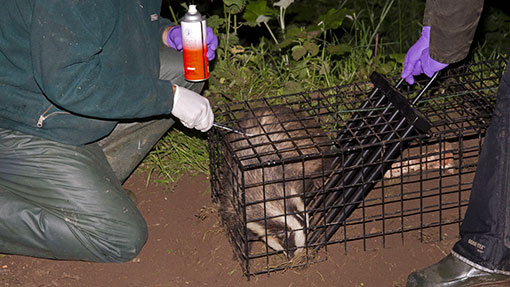Wildlife Trusts call for national badger vaccination scheme

The Wildlife Trusts are calling on the government to launch a national badger vaccination strategy to tackle bovine TB.
Ahead of the government’s badger culls starting in Somerset and Gloucestershire for the second year, the trusts are calling for a nationally coordinated, and funded, badger vaccination strategy to be delivered in conjunction with measures to tackle the disease in cattle.
The group says vaccination schemes are a “practical, cost-effective option” in dealing with the disease in badgers.
A report published by the organisation reveals the progress of 10 badger vaccination schemes over the past three years.
These schemes have seen vaccinations given on Wildlife Trusts nature reserves and privately-owned land, in partnership with farmers, vets and other landowners.
The report reveals lessons learned from activity so far as well as a detailed description of the vaccination process, including costs of £380 per dose administered, equivalent to £998 per sq km.
Cost of delivery is variable and depends on the size, nature and accessibility of the sites involved, the report says.
First year costs are generally much higher than ongoing costs due to training, certification and capital equipment requirements.
Vaccination across large areas of land or adjoining land units, however, will reduce delivery costs if equipment and resources can be shared, and is expected to provide greater disease control benefits within badger populations.
Paul Wilkinson, head of living landscape for The Wildlife Trusts, said: “We work very closely with the farming community, as well as being significant farmers and landowners in our own right, and are very conscious of the hardship that bTB causes.
“Culling badgers is not the answer; it won’t significantly reduce disease prevalence in cattle and could even make the situation worse, due to the perturbation effect where the disease is spread by badgers moving between setts post-cull.
“We firmly believe that vaccination offers the most effective, long-term and sustainable approach to bTB in badgers, and there is a strong scientific evidence base supporting this view. However, addressing the disease in badgers can at best make a limited contribution to the eradication of bTB in cattle.
“Cattle-to-cattle transmission represents the most important route of disease spread, so it is vital that the main focus of the government’s strategy to eradicate bTB remains on cattle measures, as this is where the most significant disease-control gains will be made.”
Defra says vaccinating badgers could play a big role in preventing the disease spreading from TB hotspots where the disease is rife, such as Somerset and Gloucestershire, to neighbouring counties.
The government’s new Badger Edge Vaccination Scheme (BEVS) will begin within the next few weeks in edge-area counties, spanning from Hampshire to Oxfordshire and Nottinghamshire to Cheshire.
But a Defra spokesman insisted that culling badgers was necessary to get on top of the disease in areas where it is rife.
“Overseas experience shows a comprehensive strategy is the way to make England disease free,” said the spokesman.
“This includes cattle movement controls and vaccinating healthy badgers, which could play an important role in preventing the spread of bovine TB to new areas of the country. A responsible and effective approach must also include culling in areas where the disease is rife.”
